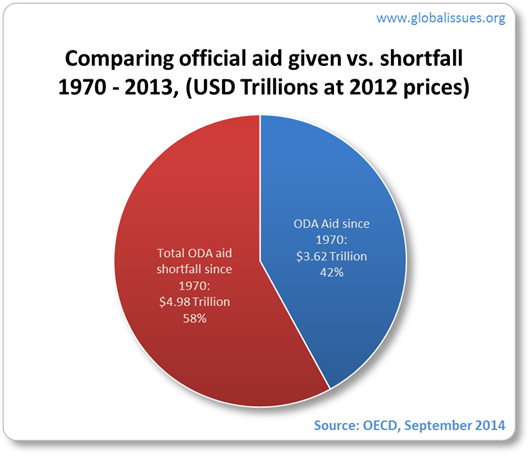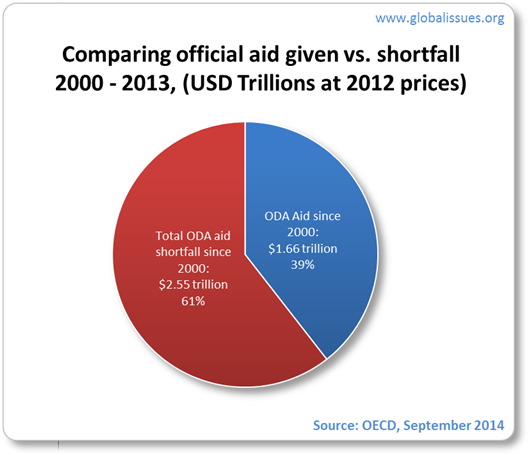Official global foreign aid shortfall: $5 trillion
Author and Page information
- This page: https://www.globalissues.org/article/593/official-global-foreign-aid-shortfall-5-trillion.
- To print all information (e.g. expanded side notes, shows alternative links), use the print version:
This article serves as a side note to the main article: Foreign Aid for Development Assistance. Please refer to that more in-depth section for additional details around aid, its quality, what constitutes aid, etc.
As detailed on the main foreign aid section:
- In 1970, rich countries of the OECD agreed at the United Nations (Resolution 2626) to give 0.7% of their GNP (now GNI) as aid to the developing countries.
- Known as ODA, this aid would be for long-term development. Side NoteIt does not include private donations and investment as these are not always predictable or used specifically for long-term development of entire economies, though their contributions can also be large.
- Over 40 years on, most of the 20 or so rich OECD countries have never reached that figure, or come close.
Annually, the global foreign aid shortfall is high.
Although rich countries have given an enormous $3.62 trillion dollars in aid since 1970, the accumulated total shortfall in their aid since 1970 (when the target of 0.7% was set) amounts to $4.98 trillion (at 2012 prices).
The remainder of this page presents a breakdown of those figures.
On this page:
Shortfall of ODA since 1970 totals over $4.98 trillion
Put bluntly, the rich owe the poor a lot of promised money, similar to the amount of total third world debt in that time:

Gap between the 0.7% target and actual ODA growing
Averaging data between the decades of the 1970s, 1980s, 1990s and 2000s, the shortfall in aid seems to be increasing:

Shortfall is more than what has been given so far
The total ODA delivered so far has been less than half of the agreed targets:
With total official foreign aid since 1970 (when the 0.7% target was set) being just over $3.6 trillion, less than half of what has been promised has been delivered:

And considering just the aid since 2000, the shortfall percentage has been even higher:

The shortfall is potentially higher as aid now includes non-aid items
The shortfall is potentially even higher, given that (as detailed in the main foreign aid section) in recent years official aid has
- Included items that it is not meant to, and
- Does not always go to the poorest countries, but instead to those of most strategic interest to the donor.
This increase has been noted since the 1990s:

Note, OECD stats from previous years included refugees, support for NGOs and administrative costs of donors in recipient DAC aid. The above stats do not contain them any more. They amounted to around 17% of the DAC aid. It is not clear if that is now subsumed by the other categories (which also unfortunately hides how much aid
is actually administrative costs of donors, for example).
Percentage of existing aid to Poorest regions
One can argue or expect that most aid would go to the poorest countries, mostly in Africa. However, this is not historically the case (though there are signs that public pressure and the Millennium Development Goals of 2015 to half poverty may encourage better aid quantity and quality).
Since 1970, on average, Sub-Saharan Africa has received about 25% of actual ODA:

Admittedly, the above graph is hard to read because most of the data is hidden by the enormous shortfall each year! If we take out the shortfall and zoom
into what is left, it is easier to see the small amount given to the poorest each year:

Shown as an average of allocation over the various regions:

In other words, the poorest got 25%. If we try to be as optimistic as we can using the above and suppose the unallocated by income
is somehow given to mostly the poor, and include the 2% that are classed as other low income countries, we get a better allocation: 50%. However, this is 50% of aid given. As aid is around two-fifths of that promised, then that 50% equates to around 20% of all aid promised. (If we stuck strictly with the least developed countries
allocation of 25%, then that 25% allocation of all promised is more like 10%.)
(Although OECD data does go back to 1960, it was in 1970 when nations agreed to the 0.7% figure. In the 1960s, aid was around 0.5% and there was a belief that it could easily be increased in coming years and reach 0.7% in the mid-1970s.)
Author and Page Information
- Created:
- Last updated:
 Global Issues
Global Issues